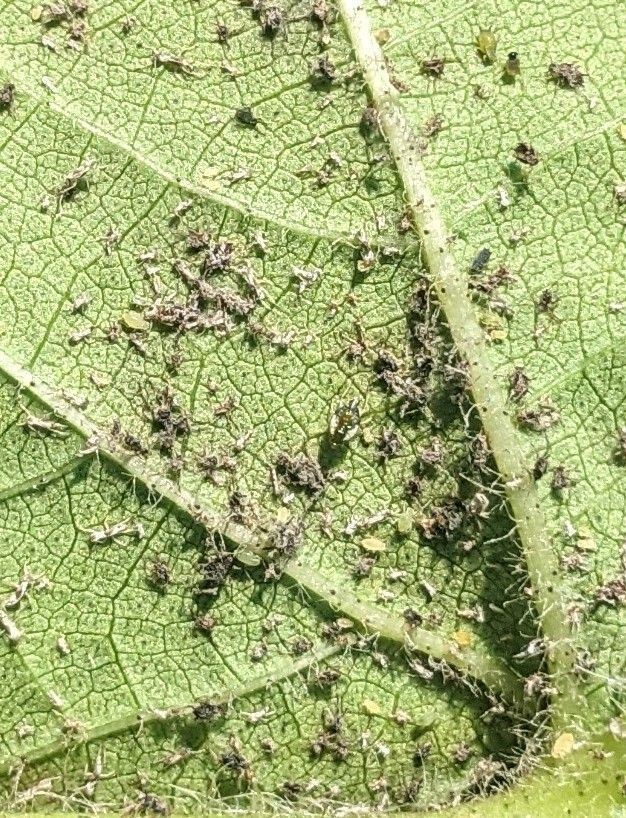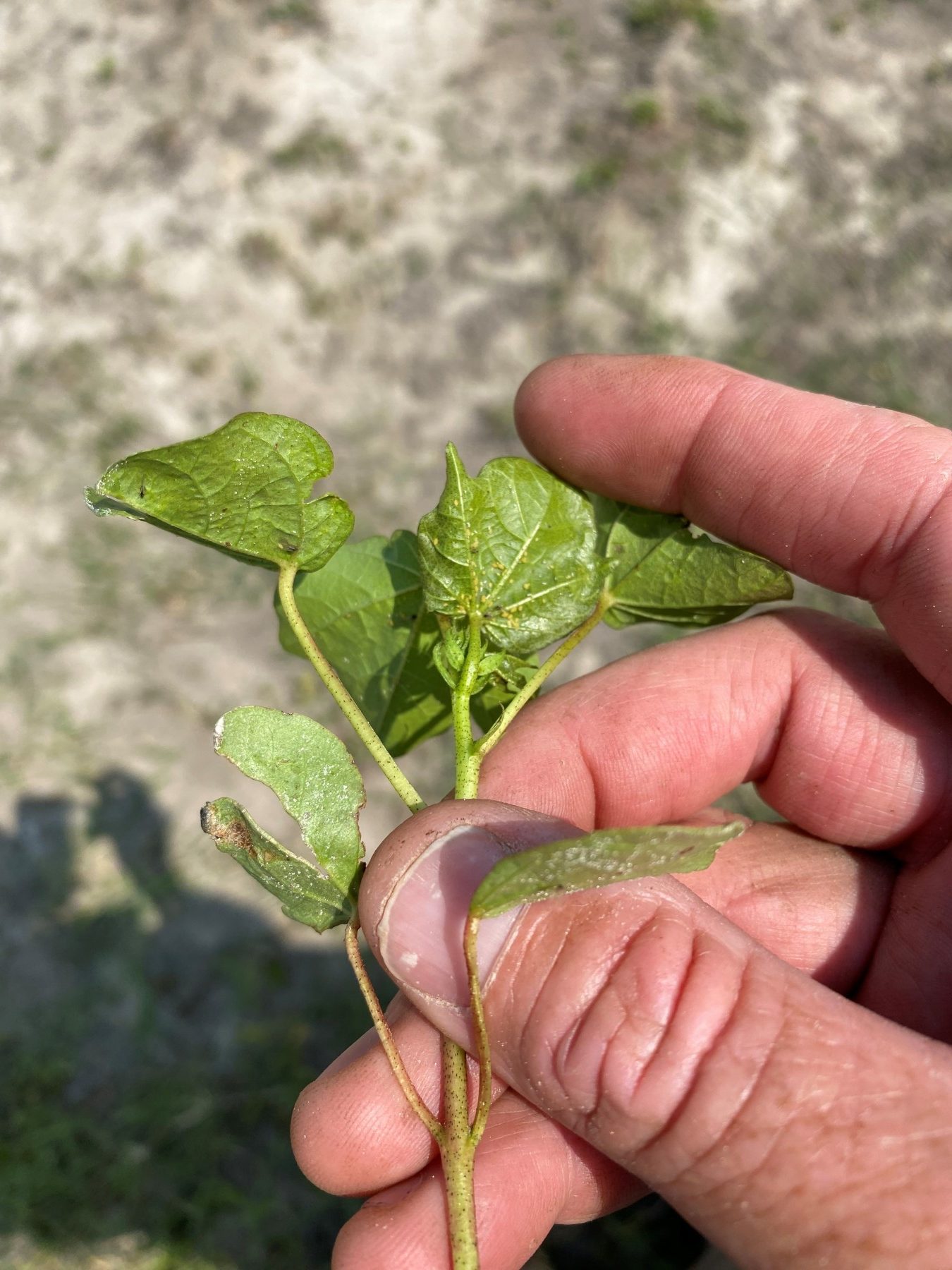Cotton: Plant bug, plant bug!! That has been the topic of the week. The cotton crop ranges from 6-8 leaf to first bloom. Plant bug pressure depends on which field you are in. Aphid pressure has been increasing but the fungus has been noticed in fields around the county by scouts and consultants. Aphids will typically build moderate to high numbers and eventually crash due to a naturally occurring fungus, Neozygites fresenii. This fungal epizootic typically occurs in late June or early July depending on location. Below is a picture of the fungus courtesy of Scott Brown.


Producers with late planted cotton need to be monitoring aphid populations.

Plant bugs — Plant bug pressure and square retention in area fields vary, thus making scouting more important. In conversation with scouts and consultants this week, square retention in fields has been dropping. Numerous fields have been treated for plant bugs. According to Dr. Phillip Roberts, UGA Cotton Entomologist, treatment is recommended when plants are retaining less than 80 percent of small squares, and numerous plant bugs are observed. Sweep nets (15 inches in diameter) are also an effective tool to monitor adult plant bugs in squaring cotton. During the first two weeks of squaring, the threshold is eight plant bugs per 100 sweeps. The threshold for plant bugs is raised to 15 per 100 sweeps beginning the 3rd week of squaring. Ideally, we should be monitoring both retention and plant bug adults with sweep nets. Our goal should be to retain at least 80 percent of 1st position squares as we enter bloom. Plants with 80 percent retention at first bloom still have maximum yield potential.
What do we treat plant bugs with? I am glad you asked. According to Phillip Roberts, it is important that we only treat plant bugs in fields where thresholds are exceeded. Some insecticides for plant bugs will decimate beneficial insects in the field (many predator insects, such as big-eyed bugs, begin colonizing fields as they begin to square). When treating plant bugs, also consider aphid populations. If aphids are present, it makes sense to use a plant bug insecticide which also has activity on aphids.
Plant bug insecticides that also have activity on aphids include Transform, Centric, and Imidacloprid. Transform is the most consistent performer on both plant bugs and aphids and is relatively “soft” on beneficial insects. Centric also provides good control of both plant bugs and aphids but is less consistent, especially on aphids. Imidacloprid provides only fair control of plant bugs and aphids. Bidrin and acephate provide good control of plant bugs but are “hard” on beneficial insects, and we generally try to delay the use of these products until later in the year. Additionally, Bidrin is not labeled on squaring cotton. I have had several questions related to the use of Diamond which is an insect growth regulator that has good activity on plant bug immatures (does not control adults). In areas of the Cotton Belt where immature plant bugs are a consistent and predictable pest, Diamond is often used. Ideally, Diamond would be applied as immatures are hatching (immature plant bugs are not
consistent nor predictable in Georgia). If you observe immature plant bugs, consideration should be given to adding Diamond to your plant bug management program. When we observe immature plant bugs, it often occurs near the first bloom. Black drop cloths are the best tool to detect immature plant bugs. During bloom, our drop cloth threshold is three plant bugs per 6 feet of row.
If you would like to read more comments from Dr. Phillip Roberts on the plant bug situation, it is available here.
Cotton irrigation requirements. I am starting to see a couple of pivots fire up depending on how much rain was received over the last few weeks. If you are interested in an irrigation phone app, then you can go to the Smart Irrigation website and select the one for cotton. Dr. Porter discussed these during the irrigation/precision ag production meeting this past winter. The apps are available here.
Below are the UGA Checkbook irrigation requirements from the UGA Production guide. As the majority of the crop ranges between first square to first bloom, then the water requirements range from 0.71 to 1.08 inches per week.

Peanuts: The area peanut crop is finally starting to grow again. Foliage feeding caterpillar and lesser corn stalk borer pressure has been low, and now is not the time to stop scouting peanuts. The threshold is 4 to 8 foliage-feeding caterpillars per foot of row. Use a lower threshold range when vines are small and/or stressed.
Irrigation requirements for 60-day peanuts are 0.23 to 0.25 inches per day. According to Wes Porter, UGA Irrigation Specialist, most soils in Georgia hold about 1 inch of water per 1 foot of soil, and peanuts cannot extract more than 50% of the soil water. One concern is shallow-rooted peanuts due to the wet weather. According to the Sunbelt Expo UGA Weather Network site, evapotranspiration rates this week ranged from 0.24 to 0.28 inches per day.
Yellow peanuts seem too common in the area, and there could be a couple of causes for this. Glenn Harris, UGA Fertility Expert, says one cause could be a temporary nitrogen deficiency from wet soils, and the peanuts should start to fix nitrogen again after soils dry out if properly inoculated at planting. Nitrogen fixation starts about 30 days after planting. Manganese deficiency
could be another reason for peanuts to be yellow. A few facts about manganese, according to the Quick Guide, if a higher soil pH (6.3>) is maintained, the higher the soil test manganese needs to be maintained to avoid manganese deficiency in peanuts. The symptom of deficiency is interveinal chlorosis, often late in the season on terminal growth. If a deficiency is confirmed by tissue
testing, apply 0.5 lb Mn/A using manganese sulfate. Yield reductions are more likely if the symptoms occur early in the growing season, so early detection and multiple sprays may be required.

What about applying plant growth regulators to peanut? Another great question. According to the UGA Peanut Quick Guide, Prohexadione calcium (PC) is the only plant growth regulator currently registered for use on peanuts. It is sold as Apogee ® or Kudos®, and is formulated as a 27.5% wettable granules. When used properly, PC treated peanut vines are shorter and more erect allowing for increased efficiency in the digging and inversion process. Unfortunately, yield increases have been erratic and often insignificant on runner type peanut due to slower growth habit compared to Virginia type peanut.
-
- PC should be applied when 50% of lateral vines from adjacent rows are touching. Sequential applications of 7.2 ounces per acre followed by 7.2 ounces per acre spaced two to three weeks apart are recommended for Virginia type peanuts. Based on recent UGA research trials, the labeled rate of 7.25 oz per acre (two application) has shown some negative impacts on yield and grade on Runners type peanuts. However, reduced rates of 3.63 oz to 5.44 oz rate applied twice has shown positive yield increases while continuing to manage vine growth similarly to the 7.25 oz/per acre rate. There are a few concerns regarding the use of PC that need to be considered.
– The use of PC is only recommended on irrigated acres where vines growth is excessive › Use of PC in non-irrigated or in irrigated fields where vine growth is not an issue will lead to stunted growth and potential yield loss.
– Application timing is crucial!
› 1st application = when greater than 50% lateral vines are touching in the row middles (Not at 50% Lapped—this will be too early) (See Photos)
› 2nd application = 14 to 21 days after 1st application – Include COC (1 quart/acre) and UAN (1 pint/acre) or AMS with PC to
help with plant uptake and consistency of performance.
– PC requires eight hours for absorption by the peanut foliage to be effective.
– PC is not recommended on plants that are under stress due to lack
of moisture, disease pressure, or other stress conditions.
- PC should be applied when 50% of lateral vines from adjacent rows are touching. Sequential applications of 7.2 ounces per acre followed by 7.2 ounces per acre spaced two to three weeks apart are recommended for Virginia type peanuts. Based on recent UGA research trials, the labeled rate of 7.25 oz per acre (two application) has shown some negative impacts on yield and grade on Runners type peanuts. However, reduced rates of 3.63 oz to 5.44 oz rate applied twice has shown positive yield increases while continuing to manage vine growth similarly to the 7.25 oz/per acre rate. There are a few concerns regarding the use of PC that need to be considered.

What about pegging zone samples? Peanuts have a high calcium requirement. Calcium must be available to the developing peg and pod in a water soluble form in the pegging zone area. If you need to apply calcium (in the form of gypsum, landplaster) it needs to be applied at early flowering. Pull the sample slightly offset of the peanut row about 3 inches deep. Pegging zone samples need to show 500 pounds of soil test calcium. If you are at the 500 mark or better and you have a 3 to 1 calcium to potassium ratio then calcium requirements should be met. If you do not meet EITHER of these requirements then you need to
apply 1000 lb/a gypsum at early bloom. Also, all peanuts grown for seed should automatically receive this gypsum
application, regardless of soil test calcium levels. Soil sample bags are available at the Extension Office if you would like
to do pegging zone tests.
What if we cannot get the gypsum applied in a timely manner? According to Dr. Glenn Harris, UGA Fertility Expert, gypsum can be applied up to 80 days after planting and still benefit the crop. If you are running late then a pegging zone sample can determine if the application is really needed.
Corn: The corn crop ranges from milk to 1/3 milk line. Corn has high water demands at this point of time, but they start to decrease once early dent stage if reached. Irrigation termination is when the corn reaches black layer.

If you have questions please contact you local county Extension agent.
Have a great week.
Jeremy M. Kichler
Colquitt County Extension Coordinator
The University of Georgia Cooperative Extension does not endorse or guarantee the performance of any products mentioned in this update.
